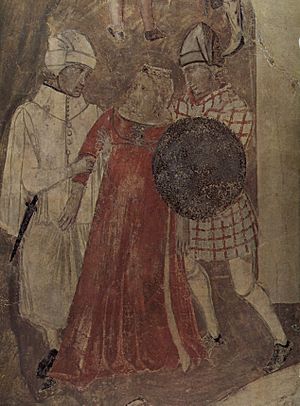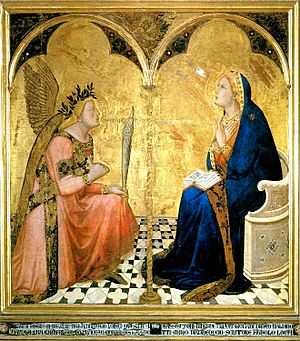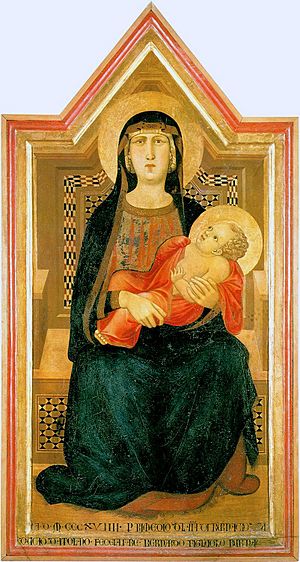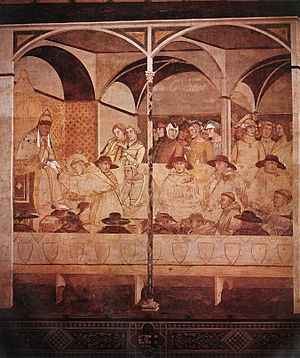Ambrogio Lorenzetti facts for kids
Quick facts for kids
Ambrogio Lorenzetti
|
|
|---|---|
 |
|
| Born | c. 1285/1290 |
| Died | 9 June 1348 (aged 57–63) Siena
|
| Nationality | Republic of Siena |
| Known for | Painting, fresco |
|
Notable work
|
Allegory of good government, Allegory of bad government |
| Movement | Gothic |
Ambrogio Lorenzetti (around 1290 – 9 June 1348) was an Italian painter from the Sienese school. He was active from about 1317 to 1348. He is famous for his paintings called The Allegory of Good and Bad Government. These paintings are in the Sala dei Nove (Council Room) in Siena's Palazzo Pubblico. His older brother, Pietro Lorenzetti, was also a painter.
Contents
Biography
Lorenzetti was greatly inspired by both Byzantine art (art from the Eastern Roman Empire) and ancient Roman and Greek art. He used these influences to create his own special style. His work was very original, which was rare back then. This was because artists often painted what their patrons (people who paid for the art) wanted.
Lorenzetti explored new ideas that later became important in the Renaissance (a period of great art and learning). For example, he experimented with perspective. This is a way of making things look 3D on a flat surface. He also studied classical antiquity, meaning ancient Greek and Roman times. His paintings clearly show how innovative he was. Other artists later copied his ideas.
His early work, like a Madonna and Child painting from 1319, shows the influence of another painter named Simone Martini. Lorenzetti worked in Florence and Siena.
His most famous work is The Allegory of Good and Bad Government. These large paintings are on the walls of the Room of the Nine (Sala dei Nove) in Siena's Palazzo Pubblico. The "nine" were the group of leaders who governed Siena. Three walls show paintings of many figures that represent virtues in the Allegory of Good Government.
On the other two walls, Ambrogio painted wide scenes. These show the Effects of Good Government on Town and Country and the Allegory of Bad Government and its Effects on Town and Country. The "well-governed town and country" painting is very well preserved. It shows many scenes from a peaceful medieval town and countryside.
The first known picture of an hourglass can be found in his painting, Allegory of Bad Government and Its Effects on Town and Country.
Like his brother, Lorenzetti is believed to have died from the bubonic plague in 1348. Giorgio Vasari wrote about Lorenzetti in his book Lives.
Selected works
Annunciation, 1344
This was Lorenzetti's last known painting. It tells the story of the Virgin Mary receiving news from an angel about the coming of baby Jesus. This painting shows one of the first uses of clear linear perspective. Even though it's not perfect, the lines on the floor help create a sense of depth.
Madonna and Child, 1319
In Madonna and Child, you can see the influence of Byzantine art. The Madonna (Mary) faces forward, which is common in Byzantine art. The Child looks up at her. In this early work, Lorenzetti shows his skill in making figures look grand and important. He used color and patterns to make the figures stand out.
Investiture of Saint Louis of Toulouse, 1329
In this fresco, St. Louis is greeted by Pope Boniface VIII. St. Louis is being given the title of Bishop of Toulouse. This fresco was part of a series painted with his brother, Pietro Lorenzetti, for Saint Francis of Assisi. This painting is known for its realistic sense of depth in an architectural setting. Lorenzetti's figures are placed in a very natural way. This shows his interest in naturalism in art. His understanding of perspective in this fresco is thought to be a preview of the Italian Renaissance.
Maestà, 1335
In his Maestà, completed in 1335, Lorenzetti used allegory. This means he used symbols to represent ideas. This painting shows his interest in literature, possibly Dante's writings. In Maestà, Lorenzetti followed the style of other Sienese painters like Simone Martini. However, he added a strong scene of a mother and child bonding. The Virgin looks at her child with deep emotion as he holds her dress. By making the Virgin Mary seem more human, Lorenzetti created a powerful emotional effect on the viewer. This shows how Sienese art was becoming more focused on human feelings.
See also
 In Spanish: Ambrogio Lorenzetti para niños
In Spanish: Ambrogio Lorenzetti para niños






